Connect With Us
Blog
Items filtered by date: May 2022
Preventing Foot Pain When Running
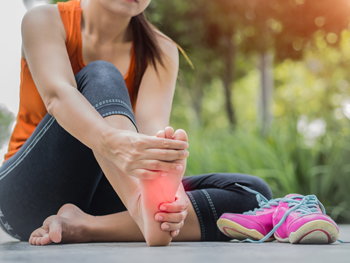
If you enjoy running, keeping your feet healthy will ensure that you can keep running and do so pain-free. Maintaining the strength of all the muscles in the foot is important in preventing pain while running. Do some simple exercises regularly to help build strong feet, which in turn will keep the foot and ankle in better alignment and reduce the risk of injury leading to foot pain. Wear comfortable shoes that fit well and that have proper support. Running shoes should be replaced regularly. Rotate running shoes so that the same areas of the feet, ankles, and legs are not repeatedly stressed. Do not try to do too much, too fast. Listen to your body and slowly build up speed and distance. Have rest days. Practicing good foot health will not guarantee freedom from running injuries but may help prevent them and make healing easier. If you feel pain while running, it is important to visit a podiatrist and get an expert’s diagnosis of the discomfort and advice on how to properly treat the problem.
Sports related foot and ankle injuries require proper treatment before players can go back to their regular routines. For more information, contact Dr. Eddy Caldwell of Foot Care of Northeast Arkansas, P.A.. Our doctor can provide the care you need to keep you pain-free and on your feet.
Sports Related Foot and Ankle Injuries
Foot and ankle injuries are a common occurrence when it comes to athletes of any sport. While many athletes dismiss the initial aches and pains, the truth is that ignoring potential foot and ankle injuries can lead to serious problems. As athletes continue to place pressure and strain the area further, a mild injury can turn into something as serious as a rupture and may lead to a permanent disability. There are many factors that contribute to sports related foot and ankle injuries, which include failure to warm up properly, not providing support or wearing bad footwear. Common injuries and conditions athletes face, including:
- Plantar Fasciitis
- Plantar Fasciosis
- Achilles Tendinitis
- Achilles Tendon Rupture
- Ankle Sprains
Sports related injuries are commonly treated using the RICE method. This includes rest, applying ice to the injured area, compression and elevating the ankle. More serious sprains and injuries may require surgery, which could include arthroscopic and reconstructive surgery. Rehabilitation and therapy may also be required in order to get any recovering athlete to become fully functional again. Any unusual aches and pains an athlete sustains must be evaluated by a licensed, reputable medical professional.
If you have any questions please feel free to contact our office located in Jonesboro, AR . We offer the newest diagnostic and treatment technologies for all your foot and ankle needs.
The Heel of My Foot Hurts!
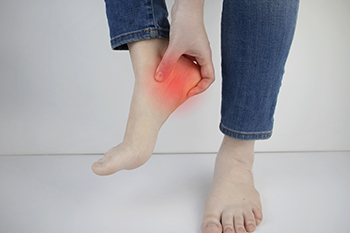
Many people complain about pain in the heel of their foot at some point in their lives. Plantar fasciitis, or inflammation of the plantar fascia, is one of the most common causes of this. The plantar fascia is the broad band of connective tissue running along the bottom of the foot that joins the heel bone to the toes, provides support for the arch of the foot, acts as a shock absorber, and bears the body’s weight. Plantar fasciitis develops when this band of tissue becomes irritated, torn, or inflamed. This condition can be extremely painful, especially with the day’s first steps. The pain at the bottom of the heel, and sometimes the midfoot area, can be sharp and stabbing or dull and achy. Once a person starts walking, the pain usually reduces but it may come on again after prolonged periods on one’s feet or when standing after sitting for a while. While causes of plantar fasciitis are not clear, research shows that heel spurs can result from plantar fasciitis, which can cause pain. This ailment is common among athletes, those who are on their feet a lot, and those who are obese. If you are suffering with heel pain, it is suggested you see a podiatrist who can make a proper diagnosis and lead you in treatment.
Plantar fasciitis is a common foot condition that is often caused by a strain injury. If you are experiencing heel pain or symptoms of plantar fasciitis, contact Dr. Eddy Caldwell from Foot Care of Northeast Arkansas, P.A.. Our doctor can provide the care you need to keep you pain-free and on your feet.
What Is Plantar Fasciitis?
Plantar fasciitis is one of the most common causes of heel pain. The plantar fascia is a ligament that connects your heel to the front of your foot. When this ligament becomes inflamed, plantar fasciitis is the result. If you have plantar fasciitis you will have a stabbing pain that usually occurs with your first steps in the morning. As the day progresses and you walk around more, this pain will start to disappear, but it will return after long periods of standing or sitting.
What Causes Plantar Fasciitis?
- Excessive running
- Having high arches in your feet
- Other foot issues such as flat feet
- Pregnancy (due to the sudden weight gain)
- Being on your feet very often
There are some risk factors that may make you more likely to develop plantar fasciitis compared to others. The condition most commonly affects adults between the ages of 40 and 60. It also tends to affect people who are obese because the extra pounds result in extra stress being placed on the plantar fascia.
Prevention
- Take good care of your feet – Wear shoes that have good arch support and heel cushioning.
- Maintain a healthy weight
- If you are a runner, alternate running with other sports that won’t cause heel pain
There are a variety of treatment options available for plantar fasciitis along with the pain that accompanies it. Additionally, physical therapy is a very important component in the treatment process. It is important that you meet with your podiatrist to determine which treatment option is best for you.
If you have any questions, please feel free to contact our office located in Jonesboro, AR . We offer the newest diagnostic and treatment technologies for all your foot care needs.
Do Your Child's Feet Hurt?
Are Flip-Flops Bad for My Feet?
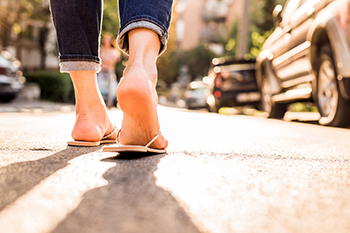
As summer nears, many of us want to go barefoot or wear flip-flops rather than closed-toed shoes and socks. Flip-flops are easy to grab and wear, can feel cool, and help with healing foot problems requiring less restriction of the feet. Their breathability can also help prevent foot infections. However, there are downsides to wearing flip-flops which generally involve their lack of padding and support. Flip-flops can be worn occasionally with no problem, but they do not absorb shock, can be dangerous in certain terrains, cause blisters from the Y strap rubbing against the skin, and negatively affect the biomechanics of the body because the stride is toe to heel versus the opposite usual stride. Wearing flip-flops can lead to pain in the back, hips, legs, and lower joints and cause other foot conditions like flat feet and plantar fasciitis. The obvious solution is to use care in wearing flip-flops and pay attention to what your feet may be telling you. If you have over-worn your flip-flops and are having problems with your feet as a result, consult with a podiatrist to check for problems and obtain a treatment regimen.
Flip-flops are not always the best choice of footwear. If you have any concerns about your feet or ankles, contact Dr. Eddy Caldwell from Foot Care of Northeast Arkansas, P.A.. Our doctor will assist you with all of your foot and ankle needs.
Flip-Flops and Feet
When the weather starts warming up, people enjoy wearing flip-flops. Flip-flops are comfortable, stylish, and easy to slip on and off; they're perfect for any summer beach goer. However, these shoes can cause harm to the feet.
How Can Flip-Flops Affect Me Long-Term?
- Ankle problems
- Hip problems
- Lower back problems
- Pain in the balls of the feet
- Problems with foot arches
- Changes in the way you walk
Are There Injuries Associated with Flip-Flops?
Yes. Since flip-flops are relatively weak and do not provide the same amount of support as sneakers, people who wear flip-flops regularly are more susceptible to injuries. On top of that, the open nature of the shoe makes your feet more prone to other problems, such as cuts and even infections. Common injuries and ailments include:
- Sprained ankles
- Blisters
- Infections
- Cuts and Scrapes
I like Wearing Flip-Flops. Are There Safe Alternatives?
When buying flip-flops, try to find ones that have sturdy soles and that are made of high-quality materials that will support for your feet. These flip-flops will cost more but will also last longer as a result.
If you have any questions please feel free to contact our office located in Jonesboro, AR . We offer the newest diagnostic and treatment technologies for all your foot and ankle needs.
Symptoms and Causes of Sever’s Disease
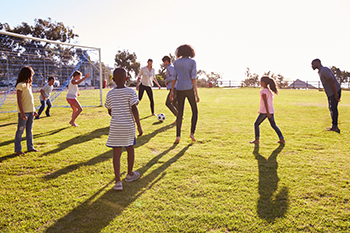
When children experience a growth spurt during puberty there can be an imbalance in the growth rate of their muscles, bones, and tendons. This is termed Sever’s disease, which generally affects children between the ages of 8 and 14. This condition occurs because the muscles and tendons in the heel become tight, pulling on the growth plate (cartilage) in the back of the heel. It is quite common in children who are particularly active in sports with a lot of running and jumping or other strenuous activities, such as gymnastics and dancing. Your child may experience redness or swelling in the back of the heel, stiffness in the feet first thing in the morning, and pain when the heel is squeezed on both sides. You also may notice them limping or walking on their tiptoes. Cutting down on the activities which induce the pain is one way to help alleviate symptoms of Sever’s disease, which may last for a few months. To be on the safe side, however, it is a good idea to introduce your child to a podiatrist who can conduct a full examination and suggest a program of treatment.
Sever's disease often occurs in children and teens. If your child is experiencing foot or ankle pain, see Dr. Eddy Caldwell from Foot Care of Northeast Arkansas, P.A.. Our doctor can treat your child’s foot and ankle needs.
Sever’s Disease
Sever’s disease is also known as calcaneal apophysitis, which is a medical condition that causes heel pain I none or both feet. The disease is known to affect children between the ages of 8 and 14.
Sever’s disease occurs when part of the child’s heel known as the growth plate (calcaneal epiphysis) is attached to the Achilles tendon. This area can suffer injury when the muscles and tendons of the growing foot do not keep pace with bone growth. Therefore, the constant pain which one experiences at the back of the heel will make the child unable to put any weight on the heel. The child is then forced to walk on their toes.
Symptoms
Acute pain – Pain associated with Sever’s disease is usually felt in the heel when the child engages in physical activity such as walking, jumping and or running.
Highly active – Children who are very active are among the most susceptible in experiencing Sever’s disease, because of the stress and tension placed on their feet.
If you have any questions, please feel free to contact our office located in Jonesboro, AR . We offer the newest diagnostic and treatment technologies for all your foot and ankle injuries.
When to Use Heat or Ice to Reduce Pain
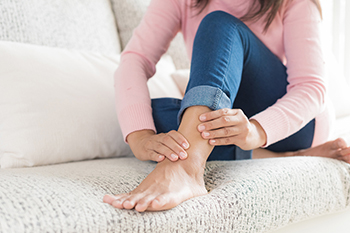
It is common for many people to reach for either an ice pack or a heating pad when they experience minor toe, foot or ankle pain. Heat and ice do frequently work to relieve discomfort, but knowing which one to use can be confusing. The first thing to know is that heat causes blood vessels to open (dilate), and ice causes them to constrict. Heat brings more blood to the injured area, helping to ease pain, spasm and stiffness. It is usually recommended for aching muscles, cramps or stiffness. A heat compress should not be overly hot, or it can burn the skin. A cloth or towel between the compress and the skin is suggested. On the other hand, it is not a good idea to use heat on a new injury, because it can add to any bleeding under the skin. Ice is more often used immediately after an injury to reduce pain, swelling and bruising, and to help numb the area. It is wise to place a cloth or towel between the ice pack and the skin and to leave the ice pack on for no longer than 30 minutes. After a severe ankle injury, especially if you think you may have torn a ligament or broken a bone, it is suggested that you visit a podiatrist immediately for examination, diagnosis and treatment.
Wound care is an important part in dealing with diabetes. If you have diabetes and a foot wound or would like more information about wound care for diabetics, consult with Dr. Eddy Caldwell from Foot Care of Northeast Arkansas, P.A.. Our doctor will assess your condition and provide you with quality foot and ankle treatment.
What Is Wound Care?
Wound care is the practice of taking proper care of a wound. This can range from the smallest to the largest of wounds. While everyone can benefit from proper wound care, it is much more important for diabetics. Diabetics often suffer from poor blood circulation which causes wounds to heal much slower than they would in a non-diabetic.
What Is the Importance of Wound Care?
While it may not seem apparent with small ulcers on the foot, for diabetics, any size ulcer can become infected. Diabetics often also suffer from neuropathy, or nerve loss. This means they might not even feel when they have an ulcer on their foot. If the wound becomes severely infected, amputation may be necessary. Therefore, it is of the upmost importance to properly care for any and all foot wounds.
How to Care for Wounds
The best way to care for foot wounds is to prevent them. For diabetics, this means daily inspections of the feet for any signs of abnormalities or ulcers. It is also recommended to see a podiatrist several times a year for a foot inspection. If you do have an ulcer, run the wound under water to clear dirt from the wound; then apply antibiotic ointment to the wound and cover with a bandage. Bandages should be changed daily and keeping pressure off the wound is smart. It is advised to see a podiatrist, who can keep an eye on it.
If you have any questions, please feel free to contact our office located in Jonesboro, AR . We offer the newest diagnostic and treatment technologies for all your foot care needs.






